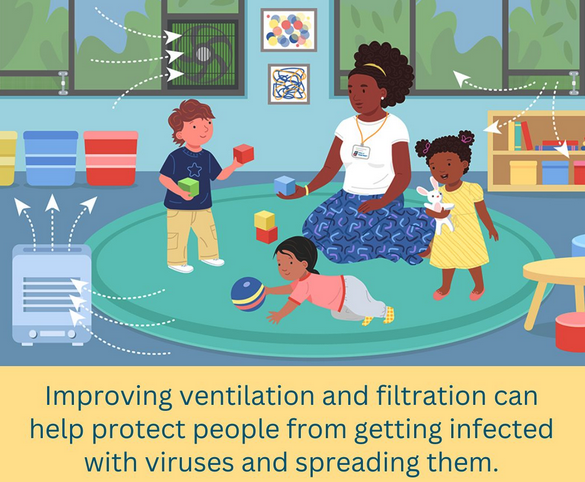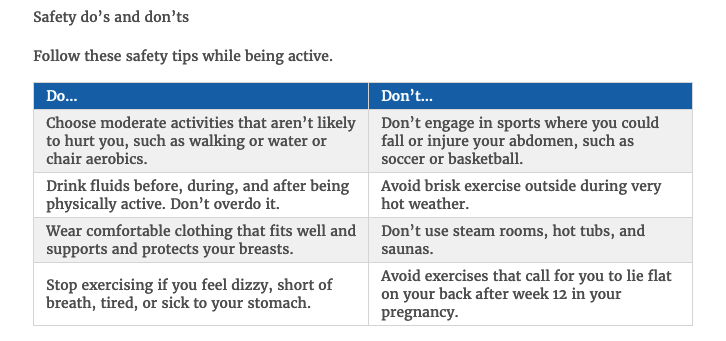It is not too late to get the flu vaccine! Around 80% of all flu cases occur in January, February and March. Talk with your pediatrician about how vaccinations teach the immune system how to protect your child from viruses like the flu and COVID.
Indoor Air Quality and Ventilation
The quality of the air we breathe affects the health and well-being of children, staff, and families. Indoor air can be improved with good ventilation that moves air in and out of buildings. Explore tips and strategies you can use at home and in buildings.
How does indoor air quality relate to children’s health?
Poor indoor air quality can affect children’s breathing, learning, and development.
Young children are sensitive to poor air quality, especially children with respiratory illnesses or chronic health conditions such as asthma.
Viral particles spread between people more easily indoors than outdoors.
Improving ventilation and filtration can help protect people from getting infected with viruses and spreading them.
What affects air quality?
Infectious disease
Smoke/wildfire smoke
Extreme heat
Air pollution
Mold and mildew
Pesticides
Cleaning products
Air fresheners
Perfume or fragrances
What is ventilation?
Ventilation moves fresh air into, out of, or within a room.
It also clears odors, germs, and other harmful particles from the air.
Ventilation reduces the number of viral particles in the air and lowers the risk of exposure to respiratory viruses.
What is filtration?
Filtration traps particles on a filter to remove them from the air.
It can also help prevent virus particles and smoke from accumulating in indoor air.
What strategies improve ventilation and filtration in homes and buildings?
Open windows, whether at home or in a building.
Opening windows allows fresh outside air to mix with indoor air. Opening windows and doors on opposite sides of the room creates cross-ventilation.
Safety tip: Windows that children can reach should open less than 4 inches or have a properly installed window guard.
Use fans.
Fans help mix the air within a room or move air from inside to outside and vice versa.
Free-standing fans can blow air away from people and increase the air flow in a room.
Fans safely secured in an open window or placed next to it blow the inside air out.
Ceiling fans move air upward or downward.
Bathroom and kitchen fans are usually exhaust fans that move air from inside to the outdoors.
Safety tip: Place fans to avoid creating a safety hazard. Make sure no one can trip over the cord, knock the fan over, touch the fan blades, or collide with the fan.
Make sure the heating, ventilation, and air conditioning (HVAC) system works properly.
Many buildings filter outdoor air and recirculate indoor air through an HVAC system. Work with a ventilation consultant when designing a new building, renovating, or upgrading a ventilation system. Maintain an HVAC system regularly as recommended by the manufacturer.
Air filters are part of an HVAC system. They block and catch small particles, making air healthier to breathe. You can gauge a filter’s effectiveness by checking its Minimum Efficiency Reporting Values (MERV) rating. Filters rated MERV 13 or higher are the most effective. Change filters regularly, according to the manufacturer’s instructions.
An HVAC professional should regularly check a building’s HVAC system to:
Make sure the air change per hour (ACH) is at least 5 ACH.
Adjust settings to bring inside as much outdoor air as possible, or to close the flow of air.
Perform regular maintenance.
If a building does not have an adequate HVAC system, a portable air cleaner with a filter can remove harmful particles in the air.
Check product information for the room size that the machine can clean, the particle size that the filter traps, and its clean air delivery rate (CADR). Use an air cleaner with a CADR that is at least two-thirds the square footage of the space.
Safety tip: Some electronic air cleaners (ionizers) create ozone as a byproduct. Breathing ozone has serious health risks. A mechanical air cleaner that pulls air through a filter is safer.
What strategies keep children safe?
Do not open windows if the outside air is unhealthy to breathe. If the air outside is polluted with smoke from fires or with pesticides from agricultural spraying, for example, it could trigger asthma or allergy symptoms or have other unhealthy effects. Check airnow.gov to see if the air quality is healthy.
Make sure portable fans are safe to use around children. If they are not safe, consider using them before children arrive, when children are playing outside, and at the end of the day after children are gone.
Keep portable air cleaners out of children’s reach by using barriers or protective screens.
Health Tips for Pregnant Women - After the Baby Is Born
How can I stay healthy after my baby is born?
After you deliver your baby, your health may be better if you try to return to a healthy weight slowly. Not losing your “baby weight” may lead to overweight or obesity later in life. Slowly returning to a healthy weight may lower your chances of diabetes, heart disease, and other weight-related problems.
Healthy eating, regular physical activity, adequate sleep, and other healthy habits after your baby is born may help you return to a healthy weight and give you energy.
After your baby is born
Consume foods and beverages to meet your calorie needs.
Regular physical activity will continue to benefit your overall health. Moderate-intensity physical activity will increase your fitness and can improve your mood.
Also, physical activity does not appear to have bad effects on how much breast milk is produced, what the breast milk contains, or how much the baby grows.
How may breastfeeding help?
Breastfeeding External link may or may not make it easier for you to lose weight because your body uses extra calories to produce milk. Even if breastfeeding does not help you lose weight, it’s linked to many other benefits for mother and child.
For mothers who breastfeed, experts advise External link feeding their babies only breast milk for the first 6 months—no other foods or drinks during this time. Experts suggest that those women continue breastfeeding at least until their baby reaches 12 months.
Calorie needs when you’re breastfeeding depend on how much body fat you have and how active you are. Talk with your health care professional about your calorie needs while you are breastfeeding.
Benefits of breastfeeding. Breastfeeding your baby
likely gives him or her an appropriate mix of vitamins, minerals, and other important nutrients in a liquid (breast milk) that is easy to digest
helps boost his or her immune system
helps protect your baby from common problems, like ear infections NIH external link and diarrhea
What else may help?
Pregnancy and the time after you deliver your baby can be wonderful, exciting, emotional, stressful, and tiring—all at once. These feelings may cause you to overeat, not get enough calories, or lose your drive and energy. Being good to yourself may help you cope with your feelings and follow healthy lifestyle habits.
Here are some ideas that may help.
Sleep when the baby sleeps.
Ask someone you trust to watch your baby while you nap, bathe, read, go for a walk, or go grocery shopping.
Explore groups that you and your newborn can join, such as “new moms” groups.
Don’t feel like you need to do it all on your own. Seek help from friends, family members, or local support groups.
Summary of Tips for Pregnancy
Talk to your health care professional about how much weight you should gain during your pregnancy, and regularly track your progress.
Consume foods and beverages rich in folate, iron, calcium, and protein. Talk with your health care professional about prenatal supplements (vitamins you may take while pregnant).
Eat breakfast every day.
Eat foods high in fiber, and drink fluids (particularly water) to avoid constipation.
Avoid alcohol, raw or undercooked fish, fish high in mercury, undercooked meat and poultry, and soft cheeses.
Do moderate-intensity aerobic activity at least 150 minutes a week during your pregnancy. If you have health issues, talk to your health care professional before you begin.
After pregnancy, slowly get back to your routine of regular, moderate-intensity physical activity.
Gradually return to a healthy weight.
Health Tips for Pregnant Women - Physical Activity
Should I be physically active during my pregnancy?
Almost all women can and should be physically active during pregnancy. According to current physical activity guidelines External link (PDF, 14.4 MB) , regular physical activity may
help you and your baby gain the appropriate amounts of weight
reduce backaches, leg cramps, and bloating
reduce your risk for gestational diabetes (diabetes during pregnancy)
reduce your risk for postpartum depression NIH external link
There's also some evidence that physical activity may reduce the risk of problems during pregnancy such as preeclampsia NIH external link (high blood pressure during pregnancy), reduce the length of labor and postpartum recovery, and reduce the risk of having a cesarean section (or C-section) External link.
If you were physically active before you became pregnant, you may not need to change your exercise habits. Talk with your health care professional about how to change your workouts during pregnancy.
Being physically active can be hard if you don’t have childcare for your other children, haven’t exercised before, or don’t know what to do. Keep reading for tips about how you can work around these hurdles and be physically active.
How much and what type of physical activity do I need?
According to current guidelines External link (PDF, 14.4 MB) , most women need the same amount of physical activity as they did before becoming pregnant. Aim for at least 150 minutes a week of moderate-intensity aerobic activity. Aerobic activities—also called endurance or cardio activities—use large muscle groups (back, chest, and legs) to increase your heart rate and breathing. Brisk walking is a form of aerobic activity.
How can you tell if you’re doing moderate-intensity aerobic activity? Take the “talk test” to find out. If you’re breathing hard but can still have a conversation easily—but you can’t sing—that’s moderate intensity.
If you can only say a few words before pausing for a breath, that’s called vigorous-intensity activity. If you were in the habit of doing vigorous-intensity aerobic activity or were physically active before your pregnancy, then it’s likely okay for you to continue these activities during your pregnancy.
You can talk to your health care professional about whether to or how to adjust your physical activity while you’re pregnant. If you have health issues such as obesity, high blood pressure, diabetes, or anemia (too few healthy red blood cells), ask your health care professional about a level of activity that’s safe for you and your unborn baby.
How can I stay active while pregnant?
Even if you haven’t been active before, you can be active during your pregnancy. Here are some tips.
Go for a walk where you live, in a local park, or in a shopping mall with a family member or friend. If you already have children, take them with you and make it a family outing.
Get up and move around at least once an hour if you sit most of the day. When watching TV or sitting at your computer, get up and move around. Even a simple activity like walking in place can help.
Make a plan to be active while pregnant. List the activities you’d like to do, such as walking or taking a prenatal yoga class. Think of the days and times you could do each activity on your list, such as first thing in the morning, during your lunch break from work, after dinner, or on Saturday afternoon. Look at your calendar or phone or other device to find the days and times that work best and commit to those plans.
How can I stay safe while being active?
For your health and safety, and for your baby’s, you should not do certain physical activities while pregnant. Some of these are listed below. Talk to your health care professional about other physical activities you should not do.
Health Tips for Pregnant Women - Healthy Eating
How much should I eat and drink?
Consuming healthy foods and low-calorie beverages, particularly water, and the appropriate number of calories may help you and your baby gain the proper amount of weight.
How much food and how many calories you need depends on things such as your weight before pregnancy, your age, and how quickly you gain weight. If you’re at a healthy weight, the Centers for Disease Control and Prevention (CDC) External link says you need no extra calories in your first trimester, about 340 extra calories a day in your second trimester, and about 450 extra calories a day in your third trimester.1 You also may not need extra calories during the final weeks of pregnancy.
Check with your health care professional about your weight gain. If you’re not gaining the weight you need, he or she may advise you to take in more calories. If you’re gaining too much weight, you may need to cut down on calories. Each woman’s needs are different. Your needs also depend on whether you were underweight, overweight, or had obesity before you became pregnant, or if you’re having more than one baby.
What kinds of foods and beverages should I consume?
A healthy eating plan for pregnancy includes nutrient-rich foods and beverages. The Dietary Guidelines for Americans, 2020–2025 External link recommend these foods and beverages each day
fruits and vegetables (provide vitamins and fiber)
whole grains, such as oatmeal, whole-grain bread, and brown rice (provide fiber, B vitamins, and other needed nutrients)
fat-free or low-fat milk and milk products or nondairy soy, almond, rice, or other drinks with added calcium and vitamin D
protein from healthy sources, such as beans and peas, eggs, lean meats, seafood that is low in mercury (up to 12 ounces per week), and unsalted nuts and seeds, if you can tolerate them and aren’t allergic to them.
A healthy eating plan also limits salt, solid fats (such as butter, lard, and shortening), and sugar-sweetened drinks and foods.
Does your eating plan measure up? How can you improve your habits? Try consuming fruit like berries or a banana with hot or cold cereal for breakfast; a salad with beans or tofu or other non-meat protein for lunch; and a lean serving of meat, chicken, turkey, or fish and steamed vegetables for dinner. Think about new, healthful foods and beverages you can try. Write down your ideas and share them with your health care professional.
For more about healthy eating, see the MyPlate Daily Checklist External link. It can help you make an eating plan for each trimester (3 months) of your pregnancy.
What if I’m a vegetarian?
A vegetarian eating plan during pregnancy can be healthy. Consider the quality of your eating plan and talk to your health care professional to make sure you’re getting enough calcium, iron, protein, vitamin B12, vitamin D, and other needed nutrients. Your health care professional may also tell you to take vitamins and minerals that will help you meet your needs.
Do I have any special nutrition needs now that I’m pregnant?
Yes. During pregnancy, you need more vitamins and minerals such as folate, iron, and calcium.
Getting the appropriate amount of folate is very important. Folate, a B vitamin also known as folic acid, may help prevent birth defects. Before pregnancy, you need 400 mcg per day from supplements or fortified foods, in addition to the folate you get naturally from foods and beverages. During pregnancy, you need 600 mcg. While breastfeeding, you need 500 mcg of folate per day.2 Foods high in folate include orange juice, strawberries, spinach, broccoli, beans, fortified breads, and fortified low-sugar breakfast cereals. These foods may even provide 100% of the daily value of folic acid per serving.
Most health care professionals tell women who are pregnant to take a prenatal vitamin every day and consume healthy foods, snacks, and beverages. Ask your doctor about what you should take.
What other new habits may help my weight gain?
Pregnancy can create some new food, beverage, and eating concerns. Meet the needs of your body and be more comfortable with these tips. Check with your health care professional with any concerns.
Eat breakfast every day. If you feel sick to your stomach in the morning, try dry whole-wheat toast or whole-grain crackers when you first wake up. Eat them even before you get out of bed. Eat the rest of your breakfast (fruit, oatmeal, hot or cold cereal, or other foods) later in the morning.
Eat high-fiber foods. Eating high-fiber foods, drinking water, and getting daily physical activity may help prevent constipation. Try to eat whole-grain cereals, brown rice, vegetables, fruits, and beans.
If you have heartburn, eat small meals spread throughout the day. Try to eat slowly and avoid spicy and fatty foods (such as hot peppers or fried chicken). Have drinks between meals instead of with meals. Don’t lie down soon after eating.
What foods and drinks should I avoid?
Certain foods and drinks can harm your baby if you have them while you’re pregnant. Here’s a list of items you should avoid.
Alcohol. Do not drink alcohol, such as wine, beer, or hard liquor.
Caffeine. Enjoy decaf coffee or tea, drinks not sweetened with sugar, or water with a dash of juice. Avoid diet drinks, and limit drinks with caffeine to less than 200 mg per day—the amount in about 12 ounces of coffee.3
Fish that may have high levels of mercury (a substance that can build up in fish and harm an unborn baby). Limit white (albacore) tuna to 6 ounces per week. Do not eat king mackerel, marlin, orange roughy, shark, swordfish, or tilefish. To get the helpful nutrients in fish and shellfish, you may eat up to 12 ounces of seafood per week, choosing from many safe seafood choices External link (PDF, 387.44 KB) , such as cod, salmon, and shrimp.3
Foods that may cause illness in you or your baby (from viruses, parasites, or bacteria such as Listeria or E. coli). Avoid soft cheeses made from unpasteurized or raw milk; raw cookie dough; undercooked meats, eggs, and seafood; and deli salads. Take care in choosing and preparing lunch meats, egg dishes, and meat spreads. See more food safety guidelines during pregnancy External link.
Anything that is not food. Some pregnant women may crave something that is not food, such as laundry starch, clay, ashes, or paint chips. This may mean that you’re not getting the right amount of a nutrient. Talk to your health care professional if you crave something that isn’t food. He or she can help you get the right amount of nutrients.






